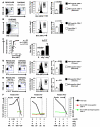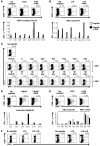Bim-mediated deletion of antigen-specific CD8 T cells in patients unable to control HBV infection
- PMID: 18398508
- PMCID: PMC2289792
- DOI: 10.1172/JCI33402
Bim-mediated deletion of antigen-specific CD8 T cells in patients unable to control HBV infection
Abstract
HBV-specific CD8(+) T cells are critical for a successful immune response to HBV infection. They are markedly diminished in number in patients who fail to control the virus, but the mechanisms resulting in their depletion remain ill defined. Here, we dissected the defective HBV-specific CD8(+) T cell response associated with chronic HBV infection by gene expression profiling. We found that HBV-specific CD8(+) T cells from patients with different clinical outcomes could be distinguished by their patterns of gene expression. Microarray analysis revealed that overlapping clusters of functionally related apoptotic genes were upregulated in HBV-specific CD8(+) T cells from patients with chronic compared with resolved infection. Further analysis confirmed that levels of the proapoptotic protein Bcl2-interacting mediator (Bim) were upregulated in HBV-specific CD8(+) T cells from patients with chronic HBV infection. Blocking Bim-mediated apoptosis enhanced recovery of HBV-specific CD8(+) T cells both in culture and directly ex vivo. Consistent with evidence that Bim mediates apoptosis of CD8(+) T cells expressing low levels of CD127 (IL-7R), the few surviving HBV-specific CD8(+) T cells were CD127(hi )and had elevated levels of the antiapoptotic protein Mcl1, suggesting they were amenable to IL-7-mediated rescue from apoptosis. We therefore postulate that Bim-mediated attrition of HBV-specific CD8(+) T cells contributes to the inability of these cell populations to persist and control viral replication.
Figures





Similar articles
-
Persistent hepatitis C virus (HCV) infection impairs HCV-specific cytotoxic T cell reactivity through Mcl-1/Bim imbalance due to CD127 down-regulation.J Viral Hepat. 2013 Feb;20(2):85-94. doi: 10.1111/j.1365-2893.2012.01618.x. Epub 2012 May 3. J Viral Hepat. 2013. PMID: 23301543
-
Bcl-2 allows effector and memory CD8+ T cells to tolerate higher expression of Bim.J Immunol. 2011 May 15;186(10):5729-37. doi: 10.4049/jimmunol.1100102. Epub 2011 Mar 30. J Immunol. 2011. PMID: 21451108 Free PMC article.
-
Bim-mediated apoptosis and PD-1/PD-L1 pathway impair reactivity of PD1(+)/CD127(-) HCV-specific CD8(+) cells targeting the virus in chronic hepatitis C virus infection.Cell Immunol. 2011;269(2):104-14. doi: 10.1016/j.cellimm.2011.03.011. Epub 2011 Mar 17. Cell Immunol. 2011. PMID: 21481848
-
The third signal cytokine IL-12 rescues the anti-viral function of exhausted HBV-specific CD8 T cells.PLoS Pathog. 2013 Mar;9(3):e1003208. doi: 10.1371/journal.ppat.1003208. Epub 2013 Mar 14. PLoS Pathog. 2013. PMID: 23516358 Free PMC article.
-
Bim and the pro-survival Bcl-2 proteins: opposites attract, ERK repels.Cell Cycle. 2007 Sep 15;6(18):2236-40. doi: 10.4161/cc.6.18.4728. Epub 2007 Jul 10. Cell Cycle. 2007. PMID: 17881896 Review.
Cited by
-
Role of T cell death in maintaining immune tolerance during persistent viral hepatitis.World J Gastroenterol. 2013 Mar 28;19(12):1877-89. doi: 10.3748/wjg.v19.i12.1877. World J Gastroenterol. 2013. PMID: 23569333 Free PMC article. Review.
-
Surveying the Metabolic and Dysfunctional Profiles of T Cells and NK Cells in Myalgic Encephalomyelitis/Chronic Fatigue Syndrome.Int J Mol Sci. 2023 Jul 26;24(15):11937. doi: 10.3390/ijms241511937. Int J Mol Sci. 2023. PMID: 37569313 Free PMC article. Review.
-
HBV-Specific Adaptive Immunity.Viruses. 2009 Sep;1(2):91-103. doi: 10.3390/v1020091. Epub 2009 Jul 27. Viruses. 2009. PMID: 21994540 Free PMC article.
-
Immunomodulation in hepatocellular cancer.J Gastrointest Oncol. 2018 Feb;9(1):208-219. doi: 10.21037/jgo.2017.06.08. J Gastrointest Oncol. 2018. PMID: 29564186 Free PMC article. Review.
-
Immunopathogenesis of chronic hepatitis B.World J Gastroenterol. 2014 Oct 21;20(39):14156-71. doi: 10.3748/wjg.v20.i39.14156. World J Gastroenterol. 2014. PMID: 25339804 Free PMC article. Review.
References
Publication types
MeSH terms
Substances
Grants and funding
LinkOut - more resources
Full Text Sources
Other Literature Sources
Medical
Research Materials

